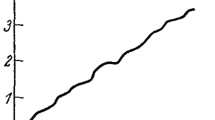Summary
A detailed investigation of the small-time deviations of the quantum nondecay probability from a pure exponential is made to study their physical consequences. Specific consideration is given to the problem of the dependence of the lifetime on the characteristics of the measuring apparata whose possible occurrence has recently been pointed out. In particular we investigate the problem of the indefinite increase of the lifetime when the frequency of the measurement processes tends to infinity, an effect referred to as Zeno's paradox in quantum mechanics. It is shown that, if the uncertainty relations are properly taken into account, the arguments leading to the paradox are not valid. Moreover, by the same kind of arguments, it is shown that the dependence of the measured lifetime on the frequency of the measurement processes, even though present in principle, is practically not detectable. To verify experimentally that the reduction process is effective one must then resort to the comparison of an experiment with reductions with one in which no interactions with the environment take place.
Riassunto
Si studiano in modo dettagliato le deviazioni a piccoli tempi della probabilità di non decadimento dalla legge puramente esponenziale e se ne indagano le conseguenze fisiche. In particolare è considerato il problema della dipendenza della vita media dalle caratteristiche degli apparecchi di misura e del suo aumento all'aumentare della frequenza delle misure, vale a dire il cosiddetto «paradosso di Zenone della meccanica quantistica». Si mostra che, ove si tenga conto in modo appropriato delle relazioni di indeterminazione, l'argomento che porta al paradosso non è più valido. Si mostra pure che la dipendenza della vita media dalla frequenza delle misure, anche se teoricamente presente, non è in pratica rilevabile sperimentalmente. L'unico modo per verificare che il processo di riduzione è effettivo è di confrontare un esperimento con riduzioni con uno in cui il sistema instabile non interagisce con l'ambiente circostante.
Резюме
Подробно исследуется отклонение квантовой вероятности нераспада при малых временах от чистой экспоненты. Особое внимание уделяется проблеме зависимости времени жизни от характеристик измерительной аппаратуры. В частности, мы исследуем проблему бесконечного увеличения времени жизни, когда частота процессов измерения стремится к бесконечности, т.е. эффект, носящий название парадокса Зено в квантовой механике. Показывается, что если соотношения неопределенностей учитываются надлежащим образом, то аргументы, приводящие к парадоксу, не справедливы. Кроме того, с помощью тех же аргументов показывается, что зависимость измеренного времени жизни от частоты процессов измерения, даже если она существует в принципе, практически не детектируема. Для экспериментальной проверки того, что процесс редуцирования является существенным, необходимо прибегнуть к сравнению эксперимента с редуцированием с экспериментом, в котором не было взаимодействий с окружающей средой.
Similar content being viewed by others
References
L. Fonda, G. C. Ghirardi andA. Rimini:Rep. Prog. Phys.,41, 587 (1978).
J. Rau:Phys. Rev.,129, 1880 (1963).
A. Beskow andJ. Nilsson:Ark. Fys.,34, 561 (1967).
H. Ekstein andA. J. F. Siegert:Ann. of Phys.,68, 509 (1971).
L. Fonda, G. C. Ghirardi, A. Rimini andT. Weber:Nuovo Cimento,15 A, 689 (1973);18 A, 805 (1973).
W. Yourgrau:Problems in the Philosophy of Science (Amsterdam,1968), p. 191.
B. Misra andE. C. G. Sudarshan:Journ. Math. Phys.,18, 756 (1977).
G. N. Fleming:Nuovo Cimento,16 A, 232 (1973).
C. Omero andT. Persi:Nuovo Cimento,49 A, 58 (1979).
R. G. Newton:Scattering Theory of Waves and Particles (New York, N. Y., 1965).
C. Chiu, E. C. G. Sudarshan andB. Misra:Phys. Rev. D,16, 520 (1977).
A. Degasperis, L. Fonda andG. C. Ghirardi:Nuovo Cimento,21 A, 471 (1974).
See,e.g.,G. Doetsch:Introduction to the Theory and Application of the Theory of Laplace Transformation (Berlin, 1974), p. 233.
G. R. Allcock:Ann. of Phys.,53, 253 (1969).
Y. Aharonov andD. Bohm:Phys. Rev.,122, 1649 (1961).
Author information
Authors and Affiliations
Additional information
Work supported in part by Istituto Nazionale di Fisica Nucleare, Sezioni di Trieste and Pavia.
Переведено редакцией.
Rights and permissions
About this article
Cite this article
Ghirardi, G.C., Omero, C., Weber, T. et al. Small-time behaviour of quantum nondecay probability and Zeno's paradox in quantum mechanics. Nuov Cim A 52, 421–442 (1979). https://doi.org/10.1007/BF02770851
Received:
Published:
Issue Date:
DOI: https://doi.org/10.1007/BF02770851




